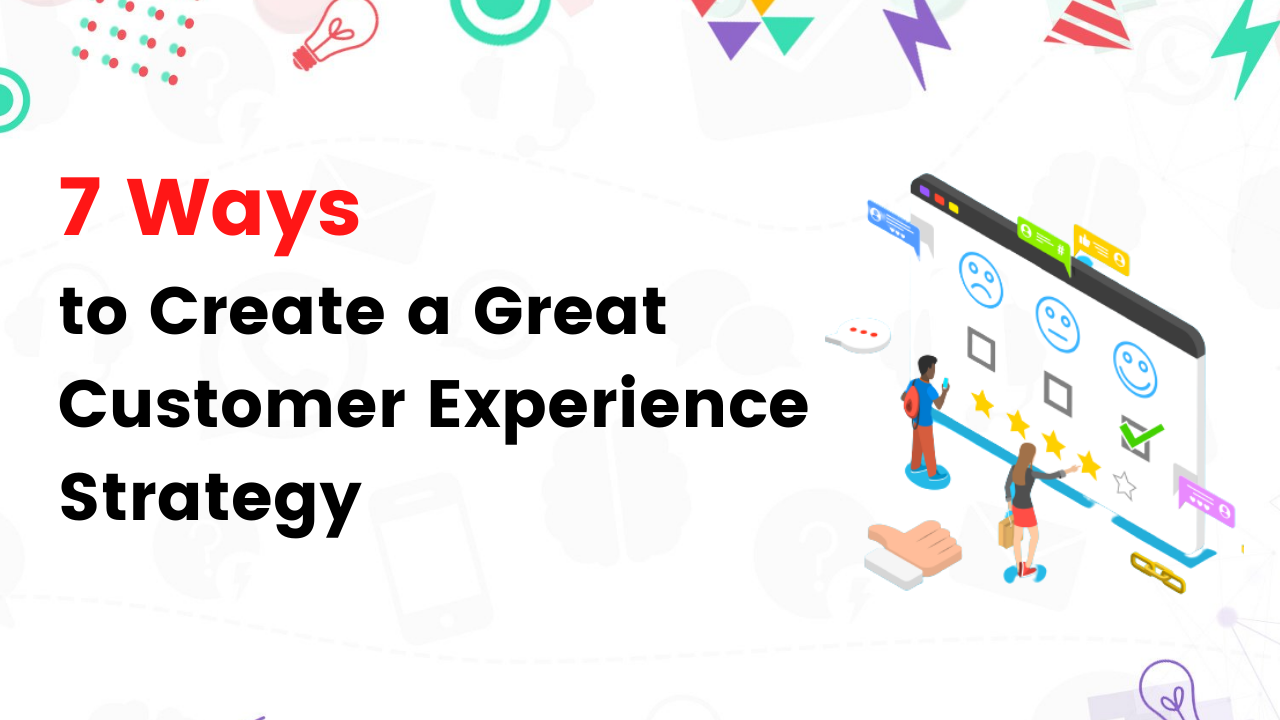Great Customer Experience Strategy. Customer experience is one of the most important factors in business success. According to Deloitte, a whopping 88% of businesses are now prioritizing customer experience in their contact centers. And on top of that, over two-thirds compete with customer experience as their primary basis.
What does all of this mean?
It’s simple: get on board, or get left behind.
In 2022, having an excellent customer experience strategy is a must if you want to survive in the cutthroat world of business.
Customers happily stay loyal to brands who share their values, earn their trust, and prioritize good service, but also readily warn and complain to friends and family about brands that provide a poor experience.
If you want to maximize sales, retain more existing customers, and avoid the nasty one-star Facebook reviews, here are seven tips for crafting the perfect customer experience strategy.
1. Set Goals and Get Clear on Your Brand Mission Statement
First and foremost, it’s absolutely essential in 2021 to be upfront about what you stand for if you ever hope to create a loyal, strong customer base.
According to HavasGroup, 77% of consumers choose to shop from brands that have the same values as them. Data from Accenture shows that 66% cite transparency as a highly attractive brand quality.
Aside from attracting customers, mission statements and company values have also proven excellent for employee retention. Research by Imperative found that 54% of purpose-oriented employees are more likely to remain with the company for five years, with 30% being more likely to become high-performing workers rather than clocking in with their eyes solely on the paycheck.
In short, having set-in-stone values prompts employees to stay with you longer and perform higher, while also giving customers a better reason to shop with you.
If you haven’t already established core values—or if you’re re-evaluating them—try to answer these two questions:
- What values can your customers relate to?
- What causes are customers contributing to by supporting your brand?
2. Research Your Target Audience Well
It’s a no-brainer that getting to know the people you want to connect with is a key to success. Of course, this will involve tons of market research and actually communicating with the consumers you want to target.
You can start by segmenting the different types of customers you want to attract and then building buyer personas around them. Give each persona a name, characteristics and traits, real-world goals and struggles, and demographics that match those of your target audience. By doing so, your will-be shoppers become more human to you, your sales teams and customer support personnel, bringing you miles closer to being able to empathize and connect with them.

3. Build a Community for Your Shoppers
Since humans have walked the earth, being in a community is one of our deepest needs.
As individuals, we don’t ever want to feel alone. Communities provide a sense of belonging and purpose—a place where we’re surrounded by like-minded people with similar goals, interests, belief systems, and values.
And believe it or not, your brand can provide that community to thousands (if not millions) of people across the globe thanks to modern innovations like social media, blogs, and email marketing.
So, how do you start creating such a space for your shoppers?
For one, you need to establish a presence where your target customers are already hanging out (hint: you can easily find these hot spots during your market research in tip #2). And I’m willing that those places don’t include the newspaper, local TV stations, or radio programs.
Today, most people spend a substantial amount of time on social media. According to Techjury, 3.196 billion people actively use it, to be exact.
To reach your audience on their platforms of choice, start by creating organic, genuine content without the purpose of selling them. You should be more informational and entertaining than promotional.
Specific strategies include sharing user-generated content (content created about you by consumers), implementing social media influencer strategies, posting engaging content with relevant hashtags, and sticking to a consistent posting schedule.

4. Reward Long-time Shoppers and Newcomers
Rewards, loyalty programs, and special discounts aren’t going anywhere any time soon.
Research by Accenture reveals that more than 90% of businesses already have some kind of loyalty program, and Yotpo data shows over 52% of loyal customers will join one.
By implementing some sort of reward system, you incentivize new people to make a purchase and encourage previous customers to buy from you again. After all, who doesn’t love saving money?
The purpose of such a system is to reward shoppers for every purchase they make, thus prompting them to make more. Starbucks for example, grants customers rewards when they make purchases through the app.
This not only keeps the customer coming back but also gives Starbucks a goldmine of data about their most loyal shoppers—what drinks they’re buying most, how often they purchase their seasonal favorites, and more.
5. Record and Act on Customer Feedback
What better way to improve your customer experience than asking your current buyers for some pointers?
There are two ways you can collect customer feedback: asking for it (via surveys, emails, SMS messages, etc.) or hunting it down yourself—and the best place to do this is social media.
According to Social Sprouts, 47% of unhappy shoppers turn to social media to voice their complaints. If you already have a presence on major platforms, they might post about their experience directly on your page (think Facebook reviews). Don’t forget to also monitor your direct messages, tags and mentions, and any hashtags that use your brand name.
Once you’ve gathered an array of positive and negative feedback, take action. What are some common features your customers recommend or complain about?
For example, customers of an ecommerce clothing store might complain that their homepages aren’t personalized to them. As a result, the clothing brand might integrate new features that suggest products based on previous purchases the shopper made. Managing customers’ orders on a more personal level can make all the difference when a customer is deciding whether they want to purchase from you again or not.
It’s easy to get discouraged by nasty reviews and negative feedback, but by viewing them as a tool rather than damage, you can drastically improve the customer experience.
Lastly, be sure to respond to complaining customers or those who participated in your survey to thank them for the feedback and let them know you’ve made their requested changes (or are in the process of doing so).

6. Ask for Employee Feedback
This is similar to the previous tip, but instead of asking shoppers for their opinions, turn to the people who work for and/or with you.
Employee feedback can be just as much of a goldmine for new ideas as your customers’ social media posts. No matter what industry you are part of, the people on your sales teams, customer service teams, and social media teams, for example, regularly deal with shoppers and the development of your product(s).
You’ll get instant advice by going to these people—they can name the most common customer complaints off the top of their heads.
As a seller, sometimes it can be easy to forget what it’s like to be a buyer. But many (if not most) of your employees aren’t sellers—they have direct communication with your customer base daily.
You can collect employee feedback similar to how you’d request it from your shoppers. Send out a company-wide email, create surveys and feedback forms, host a meeting, or simply make your rounds and ask certain people yourself.
You can then focus on equipping your employees with tools to help them better their own skills and therefore services. Remember to invest in more than just your company- investing in your employees will always have the highest ROI.
It could be simple things like offering free digital marketing programs to your marketing staff, introducing your design staff to better software, or hiring speakers to come in and have valuable discussions with your employees.
7. Prioritize Excellent Customer Service
Some people confuse “customer experience” with “customer service.” While they aren’t the same, they certainly have their ties.
Bad customer service almost always leads to a poor customer experience, whereas excellent service provokes an extremely satisfying experience.
Research by Microsoft reveals that an astounding 96% of consumers say customer service plays a major role in determining whether they’ll be loyal to a brand. Just a negative, uninterested tone of voice or one rude employee can turn away shoppers and inspire them to leave a negative review about your business.
But as an ecommerce brand (or simply a business with a website), you probably don’t have a global service team awake at all hours of the night. Meaning, who’s going to serve the customer across the world in a different timezone?
The short answer: self-service integrations like chatbots, customer advocacy software, and live chat software.
You can easily install one of these features by using a chat on your website. Then, customers can ask questions and get answers no matter what time of day (or night) it is.
Contributed by Freya Laskowsk, a personal finance expert and founder of the CollectingCents, a website that teaches readers how to grow their passive income, save money, improve their credit score, and manage debt.
Deliver An Exceptional Omnichannel Experience With CommBox
In a reality where consumers demand a fast, personalized experience, brands must deliver excellent services and customer experiences across channels. All businesses dream about a solution that can help them provide 1st class customer experience, but how can they achieve it?
One great solution for this need is CommBox – a platform that improves the customer experience across every step of the customer journey.
CommBox is an intelligent customer communication solution for sales and support centers. CommBox allows brands to boost their customer experience by quickly engaging with customers in the channel of their choice – WhatsApp, SMS, chat, Facebook Messenger, Instagram, Twitter, email, video, voice, and more! All communications are handled effectively through one smart inbox.
CommBox uses advanced AI and conversational chatbots to direct all customer inquires from multiple platforms to one smart inbox, so your agents can easily manage all customer communications from a central interface while delivering a seamless, frictionless customer experience. Plus, CommBox contains real-time dashboards and reporting systems that aggregate and analyze your customer care performance while providing customized segmentation.
With CommBox, you can:
- Unify all your communication channels and manage all interactions from one smart interface.
- Engage customers in any channel they prefer.
- Create automated chatbots for customer service and sales.
- Automate recurring tasks with ruling features.
- Integrate your CRM’s and ERPs to improve internal communication.
- Get a comprehensive view of your service quality based on customer data and reviews.
- Use analytics to improve your business performance.
- And much more…
CommBox Benefits for SMBs and Enterprises
- Seamless customer experience across all channels.
- Improved internal communication across all departments.
- Increased customer satisfaction and retention.
- Optimizes operational efficiency and reduces costs.
- Includes data that helps you grow your revenue.
CommBox paves the way for autonomous business communication without losing the quintessential human touch. Thanks to CommBox, over 300 businesses worldwide boost their customer experience, save on call centers, respond faster to inquiries and achieve great customer communication.




















